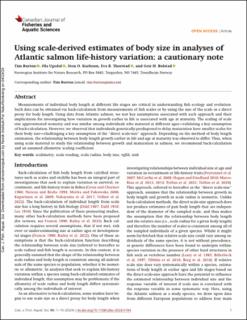Using scale-derived estimates of body size in analyses of Atlantic salmon life-history variation: a cautionary note
Peer reviewed, Journal article
Published version

Åpne
Permanent lenke
https://hdl.handle.net/11250/3127948Utgivelsesdato
2024Metadata
Vis full innførselSamlinger
- Publikasjoner fra CRIStin - NINA [2364]
- Scientific publications [1392]
Originalversjon
10.1139/cjfas-2023-0154Sammendrag
Measurements of individual body length at different life stages are critical in understanding fish ecology and evolution. Such data can be obtained via back-calculation from measurements of fish scales or by using the size of the scale as a direct proxy for body length. Using data from Atlantic salmon, we test key assumptions associated with each approach and their implications for investigating how variation in growth earlier in life is associated with age at maturity. The scaling of scale size approximated isometry and was similar among individuals who matured at different ages——validating a key assumption of back-calculation. However, we observed that individuals genetically predisposed to delay maturation have smaller scales for their body size——challenging a key assumption of the “direct scale-size” approach. Depending on the method of body length estimation, the relationship between body length growth earlier in life and age at maturity was observed to differ. Thus, when using scale material to study the relationship between growth and maturation in salmon, we recommend back-calculation and an assumed allometric scaling coefficient. scalimetry, scale reading, scale radius, body size, vgll3, six6
